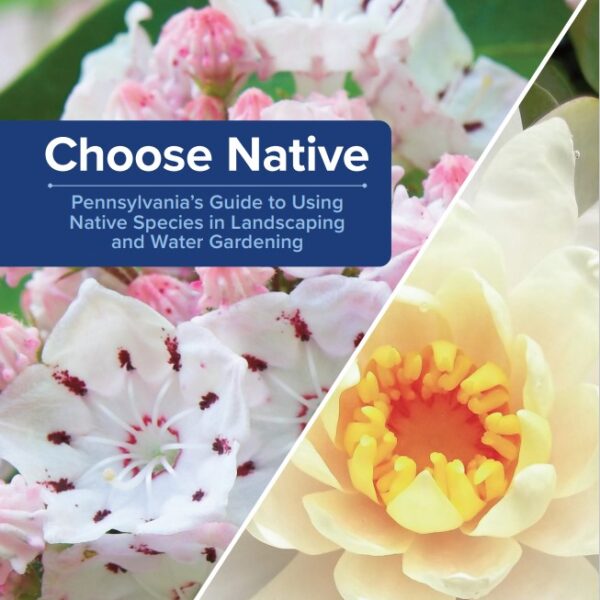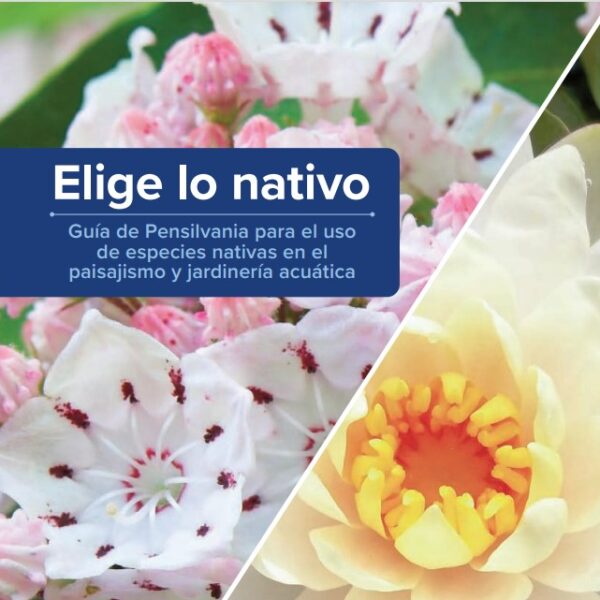Choose Native
Native species are declining across the world at an alarming rate due to habitat fragmentation, pollution, invasive species introductions, and much more. Using native species in landscaping and water gardening helps to diversify the ecosystem, provide habitat, food, and resources critically needed by native insects, birds, small mammals, pollinators, and other wildlife.
The Choose Native Initiative is a collaborative effort between Pennsylvania Sea Grant and Penn State Extension to help consumers find native alternatives to common ornamental, non-native, or even invasive species used for landscaping and water gardening.
It Started With a Survey
It started with surveying plant nurseries, growers, and industry professionals to find out which species were most commonly being used in gardening, landscaping, and water gardening projects.
The survey yielded a long list of common industry plants, many of which are non-native or even invasive species. The Choose Native team researched native alternatives for the most used non-native or invasive species. While there is no one-to-one substitution for any plant, the goal was to provide a native option that landscapers, water gardeners, and homeowners could choose for a similar place or purpose.
Workshops
The next step was to provide industry professionals with professional development opportunities and increase literacy surrounding native plants used in landscaped spaces. Three regional workshops held in March of 2024 provided details about native alternatives such as growth height, soil and sun needs, hardiness zones, and additional information like ecosystem benefits, various tolerances, and more. Workshops also focused on native species that are manageable and appropriate for regional landscapes.
A fourth virtual mini workshop was held in April of 2024, and was met with extremely high registration numbers indicating a great need for this information across the northeast region of the United States. Over 1,700 people from 12 states and Canada registered for the workshop which featured an overview of the Choose Native Initiative, an at home model of using native plants presented by a Penn State Extension Master Watershed Steward, and a tips and tricks of the trade presented by Native Creations Landscape Services which specializes in native plant landscaping. Nearly 500 people attended the webinar in person, and the workshop recording is available online through Penn State Extension. A post-workshop evaluation provided at the end of the webinar indicated that 66% of participants “fully agreed” that the mini workshop advanced their knowledge of using native plants in landscaped areas.
Field Guide
The 208-page “Choose Native – Pennsylvania’s Guide to Using Native Species in Landscaping and Water Gardening” guide serves as a portable resource to assist professional landscapers, homeowners, and garden enthusiasts in selecting native species over non-native, ornamental, or even invasive species for landscaping, gardens, and water gardens.
The guide is available in English and Spanish and is the result of a collaborative effort with Penn State Extension, with funding by the Richard King Mellon Foundation and the Great Lakes Commission.
Whether constructing a garden from scratch, converting an existing garden, or completely transforming an unwieldy non-native area into a native garden, choosing the right native species for the space is a critical step. Incorporating native species will benefit wildlife while also providing the visual appeal that every gardener desires.
The guide profiles non-native species commonly found at garden centers in Pennsylvania and nearby states. For each non-native species, there are generally two native alternatives featured. These native species are considered ‘top picks’ by the Choose Native team, meaning that they are the best native replacement in terms of size, color, performance, and other factors.
To help in choosing the right native species for the right space, each native species description includes details such as the growth height, soil and sun requirements, hardiness zones, and tolerances. In some cases, the descriptions also include unfavorable or challenging aspects to consider, such as plant spread, or even the potential harm to humans or animals.

Choose Native Guide – English

Choose Native Guide – Spanish
Why Choose Native?
Since the colonial era, there has been a long tradition of introducing non-native, exotic plants into landscapes. Many of these are horticultural creations with highly manipulated characteristics that focus on appearance and novelty, rather than function. They are often not well-adapted to local conditions and do not play a healthy role in regional ecology. Non-native plants have limited ecological functions and contribute to habitat degradation because they fail to provide necessary support to the interconnected network of native species, from essential microbial life to beneficial insects, birds, and wildlife.
Native plants, or plants that have developed regionally without human intervention, have evolved to be well-adapted to local conditions. The genetic variability of naturally propagated seed-grown native plants often makes them more resilient and survivable in unfavorable conditions, such as extreme heat or cold, disease, or pest pressure. They also tend to have a deeper, more diverse root architecture which not only helps stabilize soils and trap stormwater and runoff pollutants, but also contributes to survivability during drought. Most importantly, native plants have co-evolved with other Pennsylvania native species and provide nourishing food, appropriate nesting sites, and other ecosystem functions that support life. Large and small-scale habitat destruction and fragmentation has resulted in significant declines in native species of all types. Choosing native helps buffer against changing climate and plummeting biodiversity, and the tools and resources are readily available.
Integrating more native plants into existing landscapes and water gardens starts by considering more than just blooms. Native plants should be selected for not just beauty, but also for the benefits they contribute to site conditions and increased ecological functions. This includes providing year-round cover to the soil, offering multiple types of nectar and seeds at different times of the year, capturing pollutants, improving soil infiltration, providing nesting materials, creating sheltered spaces, increasing genetic diversity, and more. Native plants can easily be added to containers, currently unplanted spaces, or used to replace areas of low ecological value, such as portions of existing lawn or annual beds.
The Choose Native Initiative is a collaboration between Pennsylvania Sea Grant, Penn State Extension, and regional partners, with funding from the Richard King Mellon Foundation. This project would not be possible without our partnership with the Great Lakes Commission.
For more information about Choose Native, contact Amber Stilwell.



